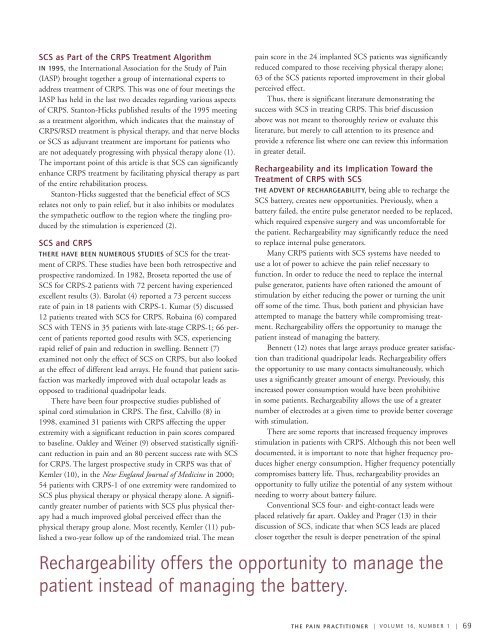printer-friendly version (PDF) - Reflex Sympathetic Dystrophy ...
printer-friendly version (PDF) - Reflex Sympathetic Dystrophy ...
printer-friendly version (PDF) - Reflex Sympathetic Dystrophy ...
Create successful ePaper yourself
Turn your PDF publications into a flip-book with our unique Google optimized e-Paper software.
SCS as Part of the CRPS Treatment Algorithm<br />
IN 1995, the International Association for the Study of Pain<br />
(IASP) brought together a group of international experts to<br />
address treatment of CRPS. This was one of four meetings the<br />
IASP has held in the last two decades regarding various aspects<br />
of CRPS. Stanton-Hicks published results of the 1995 meeting<br />
as a treatment algorithm, which indicates that the mainstay of<br />
CRPS/RSD treatment is physical therapy, and that nerve blocks<br />
or SCS as adjuvant treatment are important for patients who<br />
are not adequately progressing with physical therapy alone (1).<br />
The important point of this article is that SCS can significantly<br />
enhance CRPS treatment by facilitating physical therapy as part<br />
of the entire rehabilitation process.<br />
Stanton-Hicks suggested that the beneficial effect of SCS<br />
relates not only to pain relief, but it also inhibits or modulates<br />
the sympathetic outflow to the region where the tingling produced<br />
by the stimulation is experienced (2).<br />
SCS and CRPS<br />
THERE HAVE BEEN NUMEROUS STUDIES of SCS for the treatment<br />
of CRPS. These studies have been both retrospective and<br />
prospective randomized. In 1982, Broseta reported the use of<br />
SCS for CRPS-2 patients with 72 percent having experienced<br />
excellent results (3). Barolat (4) reported a 73 percent success<br />
rate of pain in 18 patients with CRPS-1. Kumar (5) discussed<br />
12 patients treated with SCS for CRPS. Robaina (6) compared<br />
SCS with TENS in 35 patients with late-stage CRPS-1; 66 percent<br />
of patients reported good results with SCS, experiencing<br />
rapid relief of pain and reduction in swelling. Bennett (7)<br />
examined not only the effect of SCS on CRPS, but also looked<br />
at the effect of different lead arrays. He found that patient satisfaction<br />
was markedly improved with dual octapolar leads as<br />
opposed to traditional quadripolar leads.<br />
There have been four prospective studies published of<br />
spinal cord stimulation in CRPS. The first, Calvillo (8) in<br />
1998, examined 31 patients with CRPS affecting the upper<br />
extremity with a significant reduction in pain scores compared<br />
to baseline. Oakley and Weiner (9) observed statistically significant<br />
reduction in pain and an 80 percent success rate with SCS<br />
for CRPS. The largest prospective study in CRPS was that of<br />
Kemler (10), in the New England Journal of Medicine in 2000;<br />
54 patients with CRPS-1 of one extremity were randomized to<br />
SCS plus physical therapy or physical therapy alone. A significantly<br />
greater number of patients with SCS plus physical therapy<br />
had a much improved global perceived effect than the<br />
physical therapy group alone. Most recently, Kemler (11) published<br />
a two-year follow up of the randomized trial. The mean<br />
pain score in the 24 implanted SCS patients was significantly<br />
reduced compared to those receiving physical therapy alone;<br />
63 of the SCS patients reported improvement in their global<br />
perceived effect.<br />
Thus, there is significant literature demonstrating the<br />
success with SCS in treating CRPS. This brief discussion<br />
above was not meant to thoroughly review or evaluate this<br />
literature, but merely to call attention to its presence and<br />
provide a reference list where one can review this information<br />
in greater detail.<br />
Rechargeability and its Implication Toward the<br />
Treatment of CRPS with SCS<br />
THE ADVENT OF RECHARGEABILITY, being able to recharge the<br />
SCS battery, creates new opportunities. Previously, when a<br />
battery failed, the entire pulse generator needed to be replaced,<br />
which required expensive surgery and was uncomfortable for<br />
the patient. Rechargeability may significantly reduce the need<br />
to replace internal pulse generators.<br />
Many CRPS patients with SCS systems have needed to<br />
use a lot of power to achieve the pain relief necessary to<br />
function. In order to reduce the need to replace the internal<br />
pulse generator, patients have often rationed the amount of<br />
stimulation by either reducing the power or turning the unit<br />
off some of the time. Thus, both patient and physician have<br />
attempted to manage the battery while compromising treatment.<br />
Rechargeability offers the opportunity to manage the<br />
patient instead of managing the battery.<br />
Bennett (12) notes that large arrays produce greater satisfaction<br />
than traditional quadripolar leads. Rechargeability offers<br />
the opportunity to use many contacts simultaneously, which<br />
uses a significantly greater amount of energy. Previously, this<br />
increased power consumption would have been prohibitive<br />
in some patients. Rechargeability allows the use of a greater<br />
number of electrodes at a given time to provide better coverage<br />
with stimulation.<br />
There are some reports that increased frequency improves<br />
stimulation in patients with CRPS. Although this not been well<br />
documented, it is important to note that higher frequency produces<br />
higher energy consumption. Higher frequency potentially<br />
compromises battery life. Thus, rechargeability provides an<br />
opportunity to fully utilize the potential of any system without<br />
needing to worry about battery failure.<br />
Conventional SCS four- and eight-contact leads were<br />
placed relatively far apart. Oakley and Prager (13) in their<br />
discussion of SCS, indicate that when SCS leads are placed<br />
closer together the result is deeper penetration of the spinal<br />
Rechargeability offers the opportunity to manage the<br />
patient instead of managing the battery.<br />
T H E PA I N P R A C T I T I O N E R | V O L U M E 16 , N U M B E R 1 | 69
















